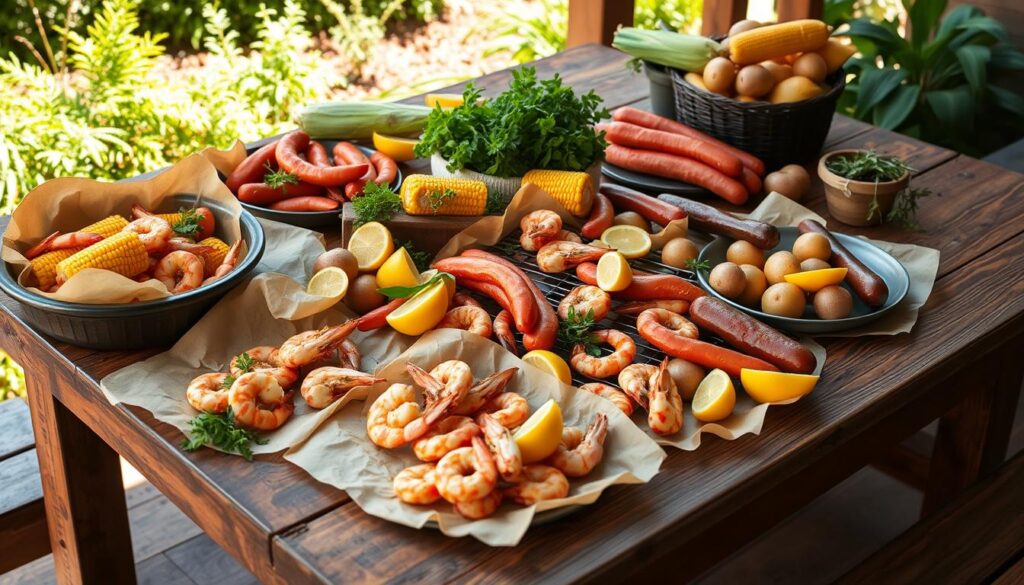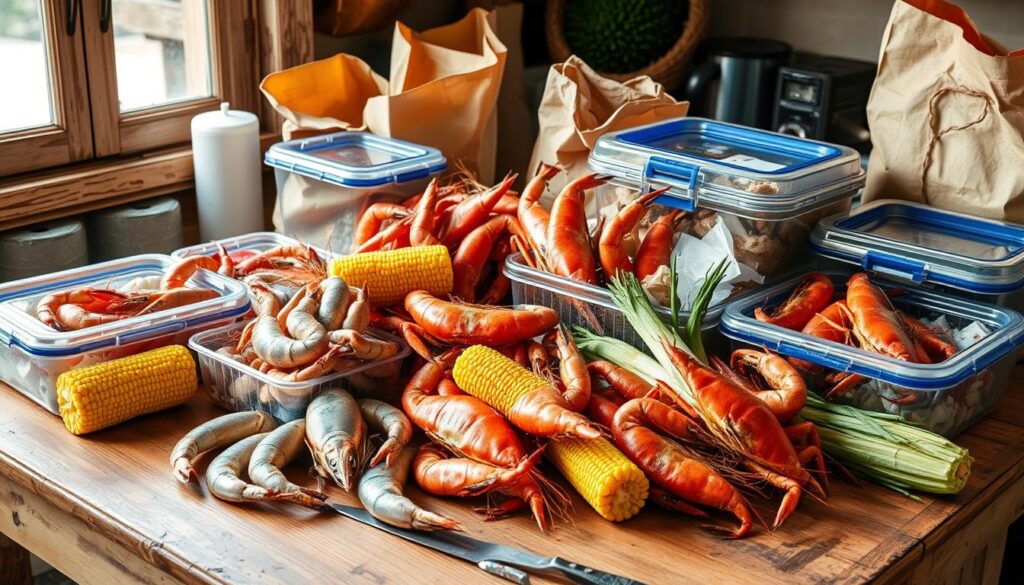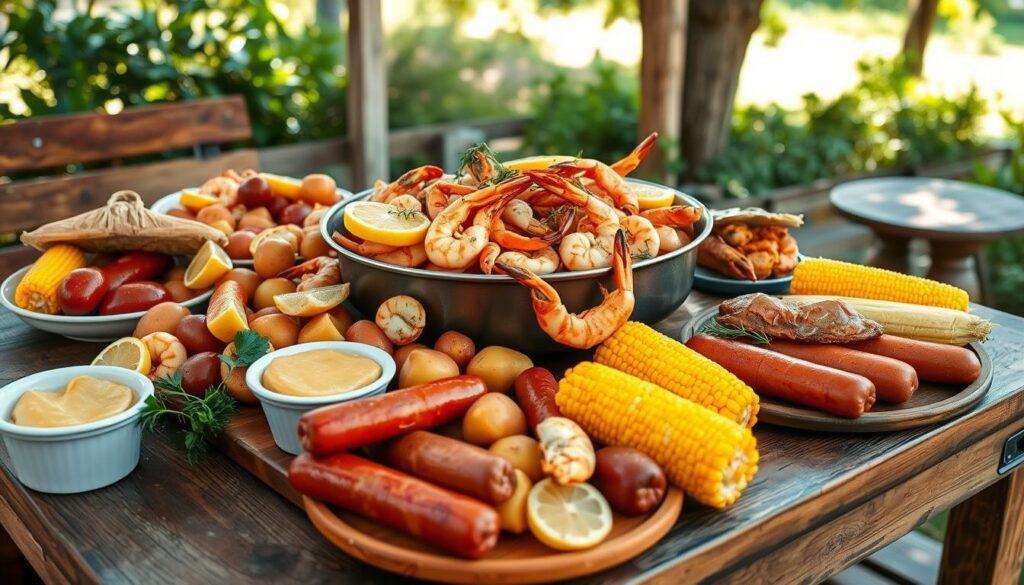In the southeastern coastal regions of the United States, the Low Country Boil is a beloved tradition. It brings people together for a seafood feast and Southern hospitality. This dish, also known as a seafood boil or Southern boil, is like a New England clambake.
It features fresh shellfish, vegetables, and spicy smoked sausage. It’s more than just a meal; it’s an event. Friends and family gather to enjoy the sea’s bounty and Southern flavors.
Key Takeaways
- A Low Country Boil is a one-pot seafood feast popular in the southeastern U.S. coastal regions.
- It typically includes shrimp, potatoes, corn, and spicy smoked sausage, seasoned with a blend of spices and sometimes beer.
- The dish is not just a meal, but a communal event where people gather to celebrate Southern hospitality and the bounty of the sea.
- The Low Country Boil is often compared to a New England clambake, but with distinct regional ingredients and cooking styles.
- Leftover Low Country Boil can be stored and reheated, making it a versatile and convenient option for feeding a crowd.
What is a Low Country Boil: Origins and Traditions
The Low Country Boil is a key dish in coastal cuisine and southern cuisine of the United States. It began as a way to feed many people. Now, it’s a beloved seafood feast tradition in Georgia and South Carolina.
The Cultural Significance in Southern Cuisine
The Low Country Boil is deeply meaningful in southern cuisine. It started as a way to cook for big groups. Now, it’s a tradition that unites people at the table.
From Necessity to Celebration
The dish’s roots are in making meals for large groups affordably. Now, it’s a coastal cuisine celebration. Families and friends look forward to it every year.
Regional Variations
While shrimp is the main ingredient, some places add crawfish or crab. It’s served on newspaper-covered tables. This makes dining together a big part of the southern cuisine spirit.
“The Low Country Boil is more than just a meal; it’s a shared experience that celebrates the rich culinary heritage of the American South.”
Essential Ingredients for Your Seafood Feast
A classic shrimp boil, also known as a Cajun boil, is a mouthwatering seafood feast. It brings the flavors of the Southern coast to your table. The key ingredients that make this dish so irresistible include:
- Succulent shrimp, the star of the show
- Small, buttery red potatoes
- Fresh, sweet corn on the cob
- Flavorful smoked sausage, often kielbasa or Andouille
For added depth and variety, you can also incorporate other seafood like crawfish or crab. The quality and freshness of the seafood are crucial for the best possible flavor. As a general guideline, aim for 2-3 pounds of shrimp and 1 pound of additional seafood per batch, which should comfortably serve around 5 people.
“The key to a truly exceptional low country boil is using the freshest, highest-quality seafood you can find. This ensures every bite bursts with flavor.”
Beyond the core ingredients, you may also want to consider adding aromatic vegetables like onions, lemons, and garlic to further enhance the dish’s flavor profile. With these essential components, you’re well on your way to creating a delectable seafood boil that will transport your guests to the heart of the Southern culinary tradition.
The Perfect Seasonings and Spices
Seasoning is the heart and soul of a Low Country Boil. The right mix of spices makes this seafood feast unforgettable. Three seasonings are favorites for adding the signature flavor to your Low Country Boil.
Old Bay Seasoning Mix
Old Bay Seasoning is a classic choice for seasoning a Low Country Boil. Recipes often call for up to 3/4 cup of this iconic blend per pot. The distinctive aroma and flavor of Old Bay’s blend of spices, including celery salt, paprika, and ground bay leaves, perfectly complement the seafood and vegetables.
Louisiana-Style Boil Seasonings
For a spicier alternative, Louisiana-style seafood boil seasonings offer a flavorful kick. Some recipes suggest using a 3-ounce package of extra-spicy boil-in-bag shrimp-and-crab boil to amp up the heat and Cajun-inspired flavors.
Adding Heat with Tabasco
To further enhance the heat, many Low Country Boil recipes call for the addition of Tabasco sauce. Typically, 1-2 teaspoons of Tabasco per batch are recommended, providing a zesty and bold finish to the dish.
The harmonious blend of Old Bay Seasoning, Louisiana-style spices, and Tabasco creates the signature flavor profile that defines a true Low Country Boil. This synergy of seasonings is the key to unlocking the full potential of your seafood feast.
| Seasoning | Amount | Purpose |
|---|---|---|
| Old Bay Seasoning | 3/4 cup | Provides a classic, well-rounded flavor |
| Louisiana-Style Boil Seasoning | 3 oz package | Adds a spicier, Cajun-inspired kick |
| Tabasco Sauce | 1-2 tsp | Enhances the heat and zesty finish |
Step-by-Step Guide to Low Country Boil
Making a delicious low country boil is simpler than you might think. This Southern seafood feast is a one-pot wonder. It combines fresh ingredients for a mouthwatering experience. Follow these simple steps to make your own seafood boil recipe at home.
- Start by boiling a large pot (at least 30 quarts) of water. Add 4 cups of chicken broth and your favorite seasonings like Old Bay seasoning, Cajun spices, peppercorns, and bay leaves.
- Once boiling, add 2.5 lbs of potatoes (mix of baby red and Yukon gold) and 1 lb of smoked sausage or kielbasa. Simmer for 15 minutes until the potatoes are tender.
- Next, add 3-4 large corn cobs, cut into thirds. Let them cook for an additional 5 minutes.
- Finally, toss in 2-3 lbs of extra-large shrimp (21/25 count) and 1 lb of scallops. Cook for 5-8 minutes until the seafood turns pink and opaque.
- After cooking, remove the pot from heat. Let the low country boil stand covered for 10 minutes before draining and serving.
| Ingredient | Quantity |
|---|---|
| Potatoes | 2.5 lbs |
| Chicken Broth | 4 cups |
| Corn Cobs | 3-4 large |
| Shrimp | 2-3 lbs |
| Scallops | 1 lb |
| Sausage/Kielbasa | 1 lb |
The secret to a perfect low country boil is layering ingredients and cooking them in stages. This ensures each element is perfectly cooked. It also creates a flavorful, aromatic broth that brings the dish together.
Cooking Times and Temperature Tips
Getting the timing right is key for a great Low Country Boil. Boil the potatoes for 10-15 minutes until they’re tender. Next, add the corn and cook for 5-10 minutes more.
Finally, add the seafood, especially the shrimp, for 3-5 minutes. They should turn opaque and curl up when done.
It’s important to keep the boil steady and rolling. This ensures even cooking. To check if the potatoes are done, pierce them with a fork. For shrimp, look for a pink, curled shape to know they’re cooked.
Layering Ingredients for Perfect Results
When making a Low Country Boil, layer the ingredients right. Start with the potatoes, as they take the longest. Then, add the corn, sausage, and onions, letting them simmer a bit.
Finally, add the seafood, like shrimp, at the end. This helps prevent overcooking.
Determining Seafood Doneness
Seafood can quickly become tough if overcooked. Watch the shrimp closely as they cook. They’re done when they turn pink and curl up.
Shrimp cook fast, in about 30 seconds. So, remove them from the boil quickly to avoid overcooking.
| Ingredient | Cooking Time |
|---|---|
| Potatoes | 10-15 minutes |
| Corn | 5-10 minutes |
| Shrimp | 3-5 minutes |
By following these tips, your Low Country Boil will be a hit. You’ll have perfectly cooked ingredients that blend together in a delicious feast.
Serving and Presentation Ideas
Serving a delicious outdoor cooking dish like Low Country Boil is key. The way you present it is as important as the taste. Traditionally, it’s served on newspaper-covered tables for a casual, shared meal.
For a fancier touch, use large bowls or decorative platters. Add fresh lemon wedges and a bit of Old Bay seasoning. This makes the dish look and smell great. It’s perfect for summer, seafood party ideas, beach parties, or backyard fun.
| Serving Style | Recommended Garnishes | Suggested Occasions |
|---|---|---|
| Served directly on a newspaper-covered table | Lemon wedges, Old Bay seasoning | Casual outdoor gatherings, backyard parties |
| Served in large bowls or on platters | Lemon wedges, Old Bay seasoning, chopped parsley | Formal events, dinner parties, beach celebrations |
How you present your Low Country Boil matters. It’s about sharing a meal with friends and family. So, get everyone together, ready to enjoy this tasty dish.

“The best part of a Low Country Boil is the shared experience of gathering around the table and diving in together.”
Accompaniments and Sauce Pairings
Make your Low Country Boil even better with different sauces and sides. A classic butter sauce is a must-have. It’s made with just a few things: melt 8 tablespoons of salted butter, add 1 tablespoon of garlic salt, and 1 tablespoon of chopped parsley. This sauce is rich and flavorful, perfect for your seafood feast.
For more variety, try cocktail sauce and tartar sauce. Cocktail sauce is zesty, with ketchup, horseradish, and lemon. Tartar sauce is creamy, with pickled relish flavors. Both are great with your seafood.
Don’t forget hot sauce for those who like a little spice. A squeeze of fresh lemon or lemon wedges can also brighten the dish. They add a burst of citrus that enhances the flavors.
Classic Butter Sauce Recipe
Ingredients:
- 8 tablespoons salted butter
- 1 tablespoon garlic salt
- 1 tablespoon chopped fresh parsley
Instructions:
- Melt the butter in a small saucepan over medium heat.
- Once melted, stir in the garlic salt and chopped parsley until well combined.
- Serve the butter sauce warm, alongside your Low Country Boil.
This simple butter sauce is a perfect match for your Low Country Boil. It’s made with rich butter, garlic, and fresh parsley. This combo makes a delicious dipping sauce that will make your meal even better.
Storage and Leftover Tips
Hosting a Low Country Boil means you’ll have lots of fresh seafood, sausage, and veggies. It’s important to manage leftovers to avoid waste and keep food safe. Here are some tips for storing and using up your leftover seafood and sides.
First, cool the Low Country Boil down to room temperature after eating. This stops harmful bacteria from growing. Put the leftovers in airtight containers and fridge them right away. Eat them within 2-3 days for the best taste and safety.
When storing, keep the seafood separate from the veggies and sausage. This stops the seafood from getting tough or rubbery when you reheat it. Reheat gently, so you don’t damage the shrimp, crab, or other seafood.
- Refrigerate leftovers in airtight containers within 2 hours of cooking
- Consume refrigerated leftovers within 2-3 days
- Separate seafood from vegetables and sausage when storing
- Reheat leftovers gently, avoiding high temperatures
Don’t waste those tasty leftovers! You can use the seafood and veggies in many dishes. Try them in salads, pasta, fried rice, or seafood cakes. With a bit of creativity, your Low Country Boil leftovers can become new, tasty meals.
| Leftover Seafood | Repurpose Ideas |
|---|---|
| Shrimp | Shrimp salad, seafood pasta, fried rice |
| Crab | Crab cakes, crab dip, crab benedict |
| Sausage | Sausage and potato hash, sausage and vegetable soup |
| Corn | Corn fritters, corn salsa, corn chowder |
| Potatoes | Potato salad, home fries, mashed potatoes |
By following these simple tips, you can enjoy your Low Country Boil flavors for days. It helps reduce waste and boosts your cooking creativity.

Conclusion
The Low Country Boil is more than a meal; it’s a celebration of coastal cuisine and community. It combines fresh seafood, vibrant veggies, and bold spices for a memorable meal. It’s perfect for backyard gatherings or beach vacations, bringing people together with its charm and flavors.
This dish is easy to make, loved by all, and holds cultural significance. It’s a tradition waiting to be started in your kitchen. From the ingredients to the fun of eating with your hands, it captures the South’s spirit. So, invite your loved ones, fire up the cooker, and enjoy the Low Country Boil’s coastal flavors.
As you enjoy each bite, imagine yourself on the sunny shores of the Carolinas. The salt air, laughter, and love for food create a perfect moment. Let the Low Country Boil become a cherished part of your seafood feast traditions.
FAQ
What is a Low Country Boil?
What are the key ingredients in a Low Country Boil?
How is a Low Country Boil seasoned?
How do you prepare a Low Country Boil?
How do you ensure proper cooking times for a Low Country Boil?
How is a Low Country Boil traditionally served?
What are some recommended accompaniments and sauces for a Low Country Boil?
How do you store and reheat leftovers from a Low Country Boil?
My team and I love hearing from you! submit your question or recipe review here :
There are no reviews yet. Be the first one to write one.

